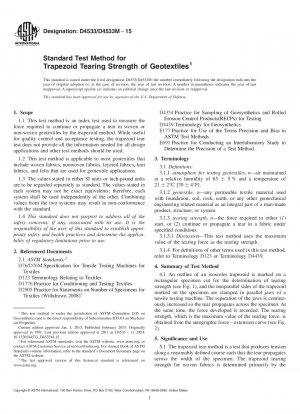ASTM D4533/D4533M-15
Standard Test Method for Trapezoid Tearing Strength of Geotextiles
- Standard No.
- ASTM D4533/D4533M-15
- Release Date
- 2015
- Published By
- American Society for Testing and Materials (ASTM)
- Status
- Replace By
- ASTM D4533/D4533M-15(2023)
- Latest
- ASTM D4533/D4533M-15(2023)
- Scope
5.1 The trapezoid tear method is a test that produces tension along a reasonably defined course such that the tear propagates across the width of the specimen. The trapezoid tearing strength for woven fabrics is determined primarily by the properties of the yarns that are gripped in the clamps. In nonwoven fabrics, because the individual fibers are more or less randomly oriented and capable of some reorientation in the direction of the applied load, the maximum trapezoid tearing strength is reached when the resistance to further reorientation is greater than the force required to rupture one or more fibers simultaneously.
5.2 The trapezoid tearing strength method is useful for estimating the relative tear resistance of different fabrics or different directions in the same fabric.
5.3 This test method may be used for acceptance testing of commercial shipments; however, caution is advised since information about between-laboratory precision is incomplete. Comparative tests as directed in 5.3.1 may be advisable.
5.3.1 In case of a dispute arising from differences in reported test results when using this test method for acceptance testing of commercial shipments, the purchaser and the supplier should conduct comparative tests to determine if there is a statistical bias between their laboratories. Competent statistical assistance is recommended for the investigation of bias. As a minimum, the two parties should take a group of test specimens that are as homogeneous as possible and that are from a lot of material of the type in question. Test specimens should then be randomly assigned in equal numbers to each laboratory for testing. The average results from the two laboratories should be compared using the appropriate Student's t-test and an acceptable probability level chosen by the two parties before testing is begun. If a bias is found, either its cause must be found and corrected or the purchaser and the supplier must agree to interpret future test results in the light of the known bias.
5.4 Most geotextile fabrics can be tested by this test method. Some modification of clamping techniques may be necessary for a given fabric, depending upon its structure. Special adaptation may be necessary with strong fabrics, or fabrics made from glass fibers, to prevent them from slipping in the clamps or being damaged as a result of being gripped in the clamps.
5.5 This test method may be used with constant-rate-of-traverse (CRT) or constant-rate-of-extension (CRE) type tension machines. However, there may be no overall correlation between the results obtained with the CRT machine and the CRE machine. Consequently, these two tension testers cannot be used interchangeably. In case of controversy, the CRE machine shall prevail.
1.1 This test method is an index test used to measure the force required to continue or propagate a tear in woven or non-woven geotextiles by the trapezoid method. While useful for quality control and acceptance testing, the trapezoid tear test does not provide all the information needed for all design applications and other test methods should be used.
ASTM D4533/D4533M-15 Referenced Document
- ASTM D123 Standard Terminology Relating to Textiles
- ASTM D1776 Standard Practice for Conditioning and Testing Textiles
- ASTM D2905 Standard Practice for Statements on Number of Specimens for Textiles
- ASTM D4354 Standard Practice for Sampling of Geosynthetics for Testing
- ASTM D4439 Standard Terminology for Geosynthetics
- ASTM D76/D76M Standard Specification for Tensile Testing Machines for Textiles
- ASTM E177 Standard Practice for Use of the Terms Precision and Bias in ASTM Test Methods
- ASTM E691 Standard Practice for Conducting an Interlaboratory Study to Determine the Precision of a Test Method
ASTM D4533/D4533M-15 history
- 2023 ASTM D4533/D4533M-15(2023) Standard Test Method for Trapezoid Tearing Strength of Geotextiles
- 2015 ASTM D4533/D4533M-15 Standard Test Method for Trapezoid Tearing Strength of Geotextiles
- 2011 ASTM D4533-11 Standard Test Method for Trapezoid Tearing Strength of Geotextiles
- 2004 ASTM D4533-04(2009) Standard Test Method for Trapezoid Tearing Strength of Geotextiles
- 2004 ASTM D4533-04 Standard Test Method for Trapezoid Tearing Strength of Geotextiles
- 1991 ASTM D4533-91(1996) Standard Test Method for Trapezoid Tearing Strength of Geotextiles

Copyright ©2024 All Rights Reserved